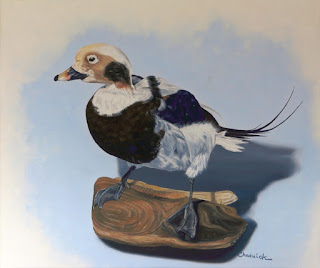This is step number 60 on my artistic journey from he winter of 1977-1978. This would have been painted in the guest bedroom of our apartment at Woodlawn Mall in Dartmouth Nova Scotia between my meteorological shifts.
The long-tailed duck (Clangula hyemalis) was historically known as oldsquaw for the sound of its call. It is a medium-sized sea duck. Sadly it is the only living member of its genus, Clangula.
Their breeding habitat is in tundra pools and marshes but also along sea coasts and in large mountain lakes in the North Atlantic region, Alaska, northern Canada, northern Europe, and Russia. The nest is built using vegetation and is lined with down and is located on the ground near water. They are migratory and winter along the eastern and western coasts of North America, on the Great Lakes, coastal northern Europe and Asia, with stragglers to the Black Sea. Surprisingly the most important wintering area is the Baltic Sea, where a total of about 4.5 million gather. The long-tailed duck is gregarious and forms large flocks in winter and during migration. They feed by diving for mollusks, crustaceans and some small fish. Although they usually feed close to the surface long-tailed ducks can dive to depths of 60 m (200 feet). According to the Audubon Society Field Guide to North American Birds they can dive to 80 fathoms (146 meters or 480 feet). They are the only ducks that use their wings to dive, which gives them the ability to dive much deeper than other ducks.
I take great pleasure in learning the nature of whatever I paint. This is were science and art really come together. The long-tailed duck is certainly a beautiful bird and I hope they out survive mankind. Did I write that out loud?
The long-tailed duck (Clangula hyemalis) was historically known as oldsquaw for the sound of its call. It is a medium-sized sea duck. Sadly it is the only living member of its genus, Clangula.
Their breeding habitat is in tundra pools and marshes but also along sea coasts and in large mountain lakes in the North Atlantic region, Alaska, northern Canada, northern Europe, and Russia. The nest is built using vegetation and is lined with down and is located on the ground near water. They are migratory and winter along the eastern and western coasts of North America, on the Great Lakes, coastal northern Europe and Asia, with stragglers to the Black Sea. Surprisingly the most important wintering area is the Baltic Sea, where a total of about 4.5 million gather. The long-tailed duck is gregarious and forms large flocks in winter and during migration. They feed by diving for mollusks, crustaceans and some small fish. Although they usually feed close to the surface long-tailed ducks can dive to depths of 60 m (200 feet). According to the Audubon Society Field Guide to North American Birds they can dive to 80 fathoms (146 meters or 480 feet). They are the only ducks that use their wings to dive, which gives them the ability to dive much deeper than other ducks.
I take great pleasure in learning the nature of whatever I paint. This is were science and art really come together. The long-tailed duck is certainly a beautiful bird and I hope they out survive mankind. Did I write that out loud?





No comments:
Post a Comment